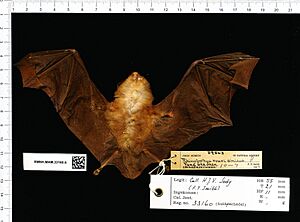Chinese rufous horseshoe bat facts for kids
Quick facts for kids Chinese rufous horseshoe bat |
|
|---|---|
 |
|
| Conservation status | |
| Scientific classification | |
| Genus: |
Rhinolophus
|
| Species: |
sinicus
|
| Subspecies | |
|
Two; see text |
|
 |
|
| Chinese rufous horseshoe bat range | |
The Chinese rufous horseshoe bat (Rhinolophus sinicus) is a type of bat. It belongs to the Rhinolophidae family, also known as horseshoe bats. You can find these bats in several countries. They live in Bhutan, China, India, Nepal, and Vietnam.
This bat looks a lot like another bat called R. affinis. Scientists tell them apart by looking at specific features. For example, the Chinese rufous horseshoe bat has a certain shape to its nose leaf. It also has a shorter bone in its third finger.
Contents
What Are the Types of Chinese Rufous Horseshoe Bats?
The Chinese rufous horseshoe bat has two main groups, called subspecies. These groups are slightly different from each other.
- R. s. septentrionalis
- R. s. sinicus
What Does This Bat Look Like?
The Chinese rufous horseshoe bat is a medium-sized bat. Its forearm, which is part of its wing, is about 43 to 56 millimeters (1.7 to 2.2 inches) long. Its ears are about 15 to 20 millimeters (0.6 to 0.8 inches) long. The tail of this bat measures about 21 to 30 millimeters (0.8 to 1.2 inches).
This bat looks similar to the rufous horseshoe bat. However, the Chinese rufous horseshoe bat has longer wings. It is also a bit bigger than Thomas's horseshoe bat. Its fur has two colors. The part of the hair closest to its body is brownish-white. The tips of the hairs are a reddish-brown color. The fur on its belly is lighter, usually brownish-white.
How Do These Bats Live?
Chinese rufous horseshoe bats are very social animals. They live together in groups called colonies. These colonies can be small, with just a few bats. They can also be very large, with hundreds of bats living together.
When it's time for bats to have babies, the females form special groups. These are called maternity colonies. This helps them raise their young safely. These bats often rest and sleep in caves. They sometimes share their caves with other types of bats.
Is This Bat in Danger?
The Chinese rufous horseshoe bat is listed as a "least-concern species". This means it is not currently in danger of disappearing. It has a wide range across Southeast Asia. It is also quite common in many places where it lives. Laws in China, for example, do not list this bat as a protected animal.
What About Diseases and Bats?
These bats can naturally carry certain types of viruses. One example is a virus related to severe acute respiratory syndrome–related coronavirus. Bats can carry these viruses without getting sick themselves. This is a natural part of their biology.


